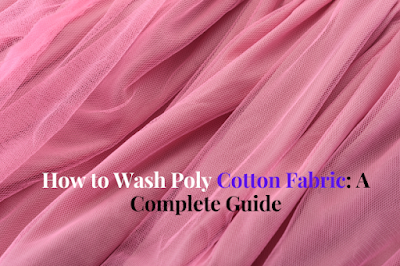Poly cotton fabric is a blend of polyester and cotton, which makes it durable, breathable, and easy to care for. However, washing this fabric can be a bit tricky, especially if you're not familiar with the proper washing techniques. In this article, we will guide you through the best practices How to wash poly cotton fabric. Here's what you need to know:
1. Read the Care Label
Before you wash any garment, it's essential to read the care label carefully. The care label provides information about the fabric type, washing instructions, and any other special care requirements. In the case of poly cotton fabric, the care label will typically indicate whether it's safe to machine wash or if it requires hand washing.
2. Sort Your Laundry
Poly cotton fabric can be washed with other fabrics, but it's essential to sort your laundry based on color and fabric type. Separate whites from colors to prevent color bleeding, and wash delicate fabrics separately to avoid damage.
3. Use the Right Water Temperature
Poly cotton fabric can be washed in hot, warm, or cold water, depending on the care label instructions. However, using hot water can cause shrinkage, so it's best to stick to warm or cold water.
4. Choose a Gentle Detergent
When washing poly cotton fabric, it's best to use a mild detergent that's gentle on the fabric. Avoid using fabric softeners or bleach, as these can damage the fibers and cause discoloration.
5. Use the Right Cycle
Poly cotton fabric can be washed using any washing machine cycle, but it's best to use a gentle cycle for delicate fabrics. If you're not sure which cycle to use, check the care label instructions.
6. Don't Overload the Washing Machine
Avoid overloading the washing machine when washing poly cotton fabric. Overloading can cause the fabric to wrinkle, twist, or damage the fibers. It's best to wash the fabric in small loads to ensure proper cleaning and prevent damage.
7. Use Cold Water for Stains
If your poly cotton fabric has a stain, it's best to treat it with cold water immediately. Avoid using hot water or rubbing the stain, as this can make it worse. Apply a small amount of detergent directly to the stain and let it sit for a few minutes before washing.
8. Avoid Overdrying
Poly cotton fabric dries quickly, so it's best to avoid over-drying. Over-drying can cause the fabric to shrink, wrinkle, or damage the fibers. Remove the fabric from the dryer while it's still slightly damp to prevent over-drying.
9. Iron on Low Heat
Poly cotton fabric is easy to iron, but it's best to use low heat. High heat can damage the fibers and cause the fabric to shrink or wrinkle. Use a low-heat iron and iron the fabric when it's slightly damp to prevent damage.
10. Store Carefully
After washing and drying poly cotton fabric, store it carefully to prevent wrinkles and damage. Fold the fabric neatly and store it in a cool, dry place away from direct sunlight.
By following these simple tips, you can keep your poly cotton fabric looking fresh and clean for longer.
Conclusion
Washing poly cotton fabric requires a bit of care and attention, but it's relatively simple if you follow the proper techniques. Always read the care label, sort your laundry, use the right water temperature and cycle, choose a gentle detergent, avoid overloading the washing machine, treat stains with cold water, avoid over-drying, iron on low heat, and store the fabric carefully
Read More:When washing poly cotton fabric

Comments
Post a Comment